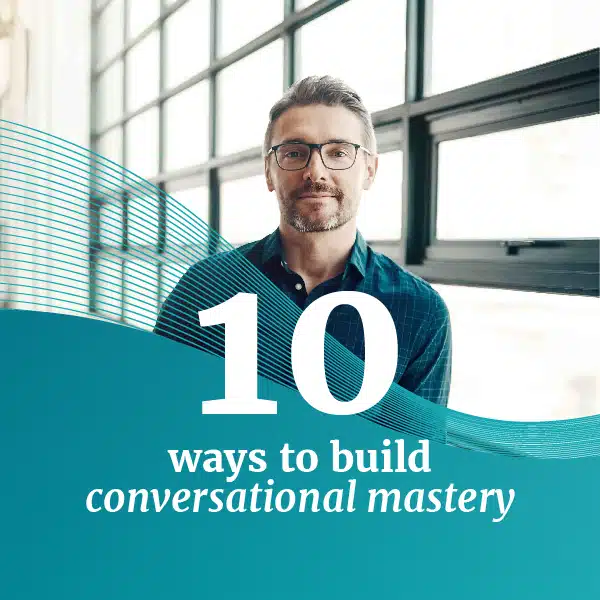10 Ways to Build Conversational Mastery
As leaders we live in conversations. We ask for others to help us, we offer support, we secure commitments, we form opinions, we build relationships, we make decisions, we get things done.
This article offers 10 ways you can be more powerful and influential in conversation, introducing fundamental insights, skills and practices you can cultivate as a leader.
Let’s begin with what stops you engaging in conversations. Perceiving that a conversation is a difficult one? Not knowing how to handle the ‘unpredictable’? Not knowing what to say? Not knowing if you can handle the feelings that may arise?
The stories, judgements and conclusions you ‘create’ about conversations, are often at the heart of both passive and aggressive responses to situations and others. The irony is that you create your stories, so if you are to make progress in terms of conversational mastery, your journey starts here.
- Understand Your Story
Your appetite for conversations is usually a function of the story you’re telling yourself. Before you can make progress on conversations, it is important to understand and recognise your potential to ‘story tell’.
The words you use, whether in your head or what you say out loud, create your world. The idea is that the way you see, interpret and listen to what’s around you generates your reality ‘moment to moment’ and this process is continuous.
We all have a story. You have a version of who you think you are and how you feel you ‘should be’, and this is not something you created recently. It represents the sum of all of your experiences. It reflects the story you were born into and the social and cultural context within which you’ve lived. It reflects all of your experiences to date that have shaped the person you know yourself to be.
Your story plays out, typically unconsciously, and is lived through habits of thinking and behaving that over time become invisible to you.
Once you can begin to recognise the power of your narrative and where it both supports and undermines you, you will likely notice the influence of moods and emotions, which are never separate from your story.
Conversational mastery means unravelling any unhelpful story that might be driving unhelpful emotions. If you’re feeling hostile or afraid in relation to a conversation, start by asking these questions:
- What is the story I am telling myself about this situation?
- Is it absolutely true, or could there be another way to see it?
- What positive and constructive interpretation can I imagine to change how I feel in this very moment?
- Walk In The Other Persons Shoes
Most often, your difficult conversation will be with one other person. Almost certainly, you will have a story (we call this an assessment) about the other person, their motives and character that creates a negative emotion for you and a reluctance to speak. This can be based on past evidence, which you may treat more as a ‘fact’ about them than a story.
It can be helpful to begin shifting this conclusion. One way to do that is to put yourself in their shoes. Up to now, you might have been more focused on your world and what’s important for you. Have you taken the time to REALLY think about their world and what might be happening for them? This can open the doorway to a sense of understanding, compassion and curiosity and once these emotions start to arise, you open the pathway for a meaningful conversation. Consider these questions:
- What is happening in the world of the other person that might be driving their behaviour?
- What concerns might they be present to?
- How might my behaviour be impacting that?
- Identify What You’re Afraid Of
In all likelihood, you will be experiencing some level of concern about a forthcoming conversation. Concern driven by a story. There are layers to your story and in revealing your story, you’re likely to identify your discomfort (fear) about having the conversation. This is actually a good thing, because, once you can reveal it, you can work with it.
What are the concerns you have about the conversation? Take some time to reflect on this question. It can be helpful to write your answers down. There will be more than one answer and if you set yourself an activity of writing down ALL of your concerns, once you pass through the ‘initial thoughts’ you’ll probably arrive at a deeper level of concern.
Once you do this, you will give yourself the chance to shift from fear of the reaction of the other person to being genuinely curious about how you’ll share your concern with the other person and open a pathway to interact in a way that opens rather than closes down possibility. Consider these questions:
- What concerns do I have about this conversation?
- For all of the concerns I can identify, which one lies at the heart of this?
- How would it be for me to express the deeper concern?
- Understand Your Core Concerns
A Core Concern is the deeper level concern you take care of and what matters most for you in your sense of identity – in leadership and life. These kinds of concerns can remain dormant for much of the time and only really become prominent when you, or what you care about feels threatened. A difficult conversation can be one such provocation. It’s then that they kick in – and are most likely to influence your perception, your decisions, and how you engage in conversation.
Core Concerns sound like, ‘I don’t belong’, ‘I’m unworthy’, ‘I fear failure’, ‘I am not good enough’, ‘I am unsafe’, ‘I am an imposter’ and ‘I am incompetent’. There are more.
As a leader with an image to uphold and a job to be done, it is unlikely that you ‘play’ this narrative out loud. In fact, it is more likely that you have identified important standards you uphold as well as behaviours you enact to make sure you never feel these things, since engaging with them can feel uncertain, uncomfortable and even paralysing. Yet, they’re always operating below the surface.
While it is easy to focus on the other person, an external event or situation and assign blame, it can be more helpful for you to explore your patterns of interpreting what has happened and your direct experience of it. Consider these questions to explore your world of Core Concerns:
- When you’re provoked, feeling unsafe or at risk, what is your immediate reaction and what is the main concern that plays out?
- How do you typically take care of that concern and how does this affect your identity?
- What would change for you if the concern you have identified was not ‘leading your behaviour’ in these key moments?
- Understand and Shift Your Mood
If you’re ‘running a story’ then you’re feeling an emotion and mood. This strongly influences your willingness and capacity to step up to conversations.
If you’ve invested in an unhelpful story, then your mood is likely to be more concern-based. Moods arise in response to a narrative you have about a circumstance and a stance or position you take in relation to that narrative. Taking an opposing stance to people, events, situations and future possibilities can produce the unhelpful moods of resentment, resignation and anxiety. If you find yourself here, you’re not ready to have a conversation. You’ll need to re-invest in reversing the story that drives the emotion.
It will be far more helpful to engage in conversation from a position of acceptance. This does not mean you need to ‘like’ what has happened in the past, but you can see that continuing to invest in opposing will only produce more suffering. Other moods that will support you are the moods of ambition (‘I can do this’) and wonder (‘let’s open the conversation and see where it goes’). These moods are powerful anchors for relationships and results!
To shift your mood, and make sure you’re not in an unhelpful space, try these questions:
- What am I opposing/fighting against – what am I not accepting?
- How would it be for me ‘now’ if I stopped opposing or fighting against the situation?
- Is it possible for me to accept what’s happening?
- What mood am I now present to?
- Clarify Your Intent and Get Present
If you’ve done the work to identify your unhelpful assessments, reverse the conclusions you’ve previously invested in, identified the unhelpful mood and invested in acceptance, ambition and wonder, then you’re ready to progress towards the conversation.
If you have discovered and shifted a Core Concern, then perhaps you’ve realised the ‘gift’ of engaging in conversation. A meaningful conversation can liberate you and the other in a way that positively transforms your relationship. It can be difficult to see this opportunity if in the past, you’ve invested in the unhelpful narratives. Clearing old stories will reveal future possibilities. Imagine your conversation clearing the air, building trust, opening a new opportunity, clarifying expectations, or finding a new way to work together?
One of these kinds of objectives can be a helpful focus before you design. Focusing on these will water down the concern even further and have you approach the conversation in a constructive mood that supports your confidence and capacity to be truly present.
- What is the best possible outcome you can hope for?
- What word describes this intent in a way that is uplifting and inspiring?
- How does it feel for you to be present to that intent, and how does this show up as an expression in your body?
- Listen for Shared Understanding
If there’s one foundation to conversational mastery, it’s listening! Listening is an active process that involves your internal conversation and your interpretations of what the other person is saying. In any conversation, you have a listening prejudice and it’s important to be aware of it. You will be habitually wired to judge what’s being shared with you as ‘good or bad’, ‘right or wrong’, ‘fact or story’. Learning to notice your listening preferences and bias will help your conversational practices enormously.
Listening for Shared Understanding is the art of listening to what the other person is sharing, what they wish to communicate and, behind their words, the things they share (both verbally and non-verbally) that indicate the presence of assessments and stories.
Listening for Shared Understanding is not a ‘simple’ practice, since you will be easily caught in your automatic listening, predisposing you to take ‘recurrent’ action that produces an already made world in accordance with your own standards. These standards arise from your frames of reference, the historical and cultural stories you are born into and your life experiences.
When you try to make sense of what another person is sharing based on your frame of reference or your reality, you can inadvertently fail to take on the perspectives, intentions and meaning of the other person you are listening to. This leads to misunderstanding, misinterpretations and limits alignment, followership, trust and rapport with those you lead and live with and above all, limits what’s possible in conversation. So, begin by revealing your listening prejudice:
- When listening to others, identify what it is you are listening for?
- What are your ‘listening hot buttons’ that provoke reactions in you?
- How could you be more vigilant in conversations to avoid your own habits of listening?
- What would more ‘generous’ listening give you and the other person?
- Notice The Role Your Body Plays
Your story, moods and body are not separate. Conversational Mastery involves being highly attuned to your body and being present to the conversation and your physical responses to it. The interplay of story, moods and body dramatically impacts your conversations, since this guides the way you ‘show up’ to the other person.
If you approach a conversation with a story of defeat and a sense of fear, your body will present that, and the other person will feel it (even if you mask the emotions). Conversely, if you approach a conversation with a story of possibility and a sense of optimism, this will set you up for success, constructive listening and free you to ‘dance’ with whatever emerges in the flow of conversation.
Ahead of any planned conversation, or if a conversation arises in an unpredictable way, by simply re-arranging your body to be more upright and open, you can change your story, become more present, notice an unhelpful story and re-engage to bring about a positive outcome. Try these three reflections:
- What physiology might you adopt if you felt buoyant and optimistic about a future conversation?
- By changing your body, what changes in terms of your mood and emotions?
- How do you want to ‘show up’ to the other person in terms of physiology?
- Plan and Practice If It’s A Big Conversation
If the conversation is an important one for you or if the stakes are high, investing in preparing for the conversation will help. There are many different conversational ‘designs’ available to support a positive outcome and the design of such a conversation largely depends on your capacity to determine the difference between a fact and an assessment (story), and your capacity to engage with positive intent, a constructive mood and aligned physiology.
If you can isolate some evidence as a starting point, you might begin by sharing “I’ve noticed that….” (share the evidence), then “my concern is ….” (share your concern). If you’ve done the pre-thinking, then your mood should be constructive, and you’ll be genuinely curious about hearing what they have to say. So, finish this approach by asking a question or asking for their view.
If you have no facts and you’re only dealing with a concern, you might start more tentatively by sharing the concern. Make sure you don’t share this as though it were a fact, instead try something like this: “I have a concern I’d like to share with you, would that be OK if I shared it?” Timing will be key here, so take the other person’s lead on whether this is the right time, or if another time might be more suitable.
Finally, it can be helpful to test your approach with a trusted friend or colleague. Try it out to test how it lands with a neutral party and get feedback on how it lands. If you practice and get feedback, consider doing this 3 times or more. Try this conversation until you de-sensitise your nervous system and until the idea of doing it in real life feels accessible. Below we offer some questions for your reflection:
- What conversation might you like to begin designing?
- Who would be an appropriate confidante?
- What would change if you felt more confident to have this conversation?
- Learn to Love Identifying and Sharing Concerns
Imagine living life with a belief that any concern you had could be taken care of and navigated through conversation. What are your beliefs around conversations that are contrary to this? Where have they come from? How are they serving you?
The great news is that you’re in charge of your beliefs, they belong to you and you can choose to change an old or unhelpful belief this very moment. This will require you to reflect on and understand where your current beliefs have come from and to actively begin to construct a new belief that serves how you want to ‘show up’ in leadership and life.
This is the foundation of Conversational Mastery. Being a Master involves crafting a new narrative for yourself, grounded in a deep awareness of your historical preferences, prejudices and bias. Then, cultivating skills around presence, generous listening, conversational design and clarity on the way you wish to show up.
These skills ultimately manifest as confidence. Not a contrived sense of needing to pre-plan and pre-prepare, but a sense of openness and a capacity to ‘go with’ life and the circumstances that present. Consider these orientations:
- What new belief might help you learn to love the idea of conversations – even the ones that arise as unexpected?
- What new skills and practices might you cultivate to be able to build conversational mastery?
What becomes available for you as a leader when you’re able to share concerns honestly and kindly?
Stay in the conversation and follow us on Instagram, Facebook or LinkedIn.



